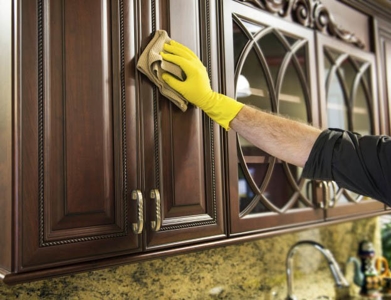
Mold indoors can create health issues for everyone living in the home, especially anyone that suffers from respiratory conditions or a compromised immune system. The Centers for Disease Control and Prevention (CDC) reports that some studies have even suggested a potential link of early mold exposure to the development of asthma in some children. If you have mold in the home, it is time to call in the mold removal professionals.
Mold in kitchen cabinets can be troublesome—your dishes, glassware, pots and even boxed food are now exposed to the fungi. The mold remediation specialists at ServiceMaster Restore® offer some of the best ways to remove mold in your kitchen cabinets, under the sink, and other hard-to-reach areas.
Causes of Mold in Kitchen Cabinets
Kitchen mold is often caused by humidity from cooking, washing dishes, or using a dishwasher. Food or food particles in your cabinets can also grow mold. Mold thrives where there is moisture, humidity and little ventilation. When the interior of a kitchen cabinet becomes wet and the dampness lingers, mold can develop.
Wood cabinets in the kitchen that are near these water sources are especially prone to mold growth. The kitchen cabinets that are most susceptible tend to be under the sink, by the dishwasher, and near your exhaust vent. These are common areas that retain heat and moisture and can be a literal petri dish for mold to thrive.
Steps for Cleaning Mold in Kitchen Cabinets
Mold in kitchens and other high-moisture areas is common. Fortunately, small mold problems inside cabinets may be removed with non-ammonia cleaners and little elbow grease.
Here’s how you can remove mold and clean your kitchen cabinets:
- Choose a commercial cleaner specifically designed to kill and remove mold. Hydrogen peroxide and household pantry items like bleach and distilled white vinegar may also remove mold. Never mix these different cleaners together.
- Spray your cleaning solution onto the mold, following the manufacturer's direction if using a commercial product. You may opt to scrub the mold away using a cloth or a stiff-bristle scrub brush. Use an old toothbrush to get into hard-to-reach areas.
- With warm water and a clean rag, thoroughly rinse the cleaning solution and residual mold from the interior of the cabinet.
- Thoroughly dry the cabinet and inspect for traces of mold. If all of the mold has not been removed, repeat the cleaning steps again, always finishing with thorough drying. If the mold still remains, it's time to call in professional help.
Quick Tips
- Always work in a well-ventilated area and wear protective gloves/safety glasses while cleaning mold off wood cabinets.
- Bleach, hydrogen peroxide and other cleaners may discolor the stained wood cabinets. Always perform a color-fastness test in an inconspicuous area before cleaning a larger portion of the cabinet to clean mold off wood.
- To prevent mold from returning in the future, it's essential to locate the origin of the moisture problem. It may be a leaking sink or dishwasher. A leak paired with inadequate ventilation can mean serious mold issues.
- If the mold has developed due to a leaking sink, it's possible you may need to remove the entire sink to access every area where the mold is growing.
- Mold that has spread under the flooring, behind the drywall or to the ceiling will require removal by professionals.
Call 1 (800) RESPOND or contact your nearest ServiceMaster Restore Location! ServiceMaster Restore offers full mold remediation for homes and businesses and can help return your kitchen and the cabinets back to their pre-mold state.
Mold In Areas Other Than Your Kitchen?
Mold can spread to other areas of your home, leading to a mold infestation throughout your home. If you see signs of mold or have dealt with water damage in your home recently, you may be at risk. See why homeowners across the United States rely on ServiceMaster Restore for their mold removal needs.
We use advanced tools and processes to detect mold and safely remove it while using protective measures to reduce the risk of spores spreading to other areas of your home. Give our team a call at 1-800-RESPOND to see how we can help you with your mold needs.
For more tips on keeping your kitchen free from mold, watch the video below.


